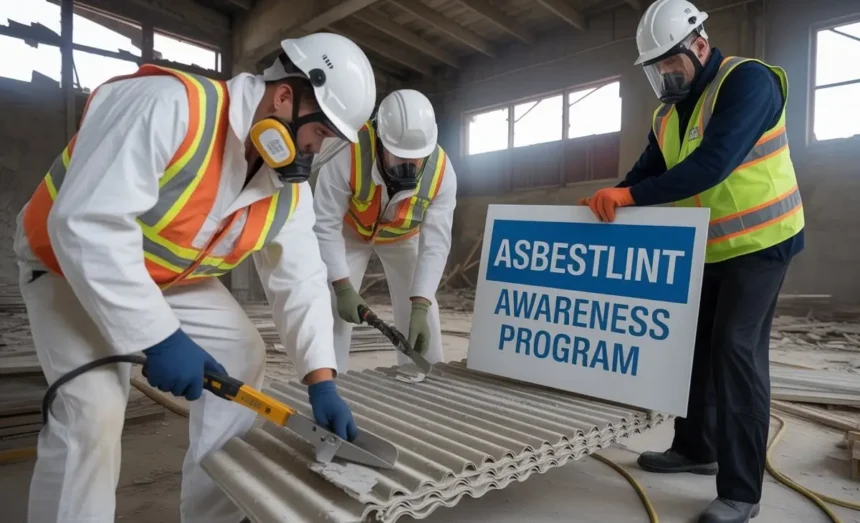The term asbestlint is often linked to asbestos-based materials that were widely used in the past for insulation, fireproofing, and construction. Asbestos was once considered a miracle material because of its durability and resistance to heat, chemicals, and electricity. However, asbestlint represents the dangerous side of this mineral fiber—the dust and tiny particles that can be released into the air. When inhaled, these particles pose severe health risks that are now well documented.
This article will explore what asbestlint is, where it comes from, its dangers, and how societies today deal with the legacy of asbestos use.
What is Asbestlint?
Asbestlint refers to the fine, fibrous particles of asbestos that can easily break loose from asbestos-containing products. Unlike solid asbestos sheets or insulation panels, lint-like asbestos fibers are microscopic and lightweight, making them easy to inhale or spread. These particles may not be immediately visible to the naked eye, which makes them particularly dangerous.
Historically, asbestlint would be produced when asbestos materials were cut, sanded, or broken apart. Even simple wear and tear in buildings, factories, or homes could release asbestos fibers into the air.
Historical Use of Asbestlint Materials
Asbestos use dates back thousands of years, but its modern industrial popularity peaked between the 19th and mid-20th centuries. It was commonly used in:
-
Construction: Insulation, roofing, cement, and floor tiles.
-
Shipbuilding: Fireproofing and soundproofing in ships.
-
Manufacturing: Brake pads, gaskets, and protective clothing.
-
Textiles: Fire-resistant fabrics that sometimes produced lint when worn or washed.
In factories where asbestos textiles were woven, workers were directly exposed to asbestlint daily. They would often carry asbestos fibers home on their clothes, unknowingly putting family members at risk as well.
Health Risks of Asbestlint
The danger of asbestlint lies in its ability to penetrate deep into the lungs. Once inhaled, asbestos fibers can remain lodged in lung tissue for decades, leading to severe diseases. Some of the major health risks include:
-
Asbestosis – A chronic lung disease caused by inhaling asbestos fibers, leading to scarring and difficulty breathing.
-
Mesothelioma – A rare but aggressive cancer of the lung lining or abdominal cavity, almost exclusively linked to asbestos exposure.
-
Lung Cancer – Exposure to asbestos dramatically increases the risk, especially in smokers.
-
Other Cancers – Studies have linked asbestos exposure to cancers of the larynx, ovaries, and digestive system.
What makes asbestlint especially hazardous is that symptoms of these diseases may not appear for 20 to 40 years after initial exposure.
Modern Awareness and Regulation
By the late 20th century, governments around the world began banning or strictly regulating asbestos use. Countries such as the United States, Canada, Australia, and most of Europe put in place safety standards to prevent asbestos exposure.
Some key regulations include:
-
Workplace safety laws requiring protective equipment for workers handling asbestos.
-
Strict disposal rules for asbestos waste.
-
Bans on asbestos-based construction materials in new projects.
-
Building inspections to ensure older structures with asbestos are safely maintained or removed.
Despite these regulations, asbestos still exists in many older homes, schools, and industrial sites, meaning the danger of asbestlint has not disappeared entirely.
Safe Handling and Removal
If asbestos materials are present in a building, the greatest risk arises when they are disturbed. Renovation, drilling, or demolition can release asbestlint into the air. To minimize risks, experts recommend:
-
Professional asbestos inspections before starting construction or remodeling.
-
Sealing or encapsulating asbestos materials if removal is not immediately necessary.
-
Hiring licensed asbestos removal teams who use specialized equipment and safety gear.
-
Avoiding DIY asbestos removal, since improper handling can make the situation worse.
The Future of Asbestlint Awareness
Today, public knowledge of asbestos dangers is far greater than in the past. Schools, businesses, and governments actively educate people about the risks. Research continues into safer methods of asbestos removal and long-term solutions for contaminated sites.
At the same time, many developing countries still use asbestos due to its low cost. This creates a global health concern, as workers in those regions may face the same deadly exposure risks that industrialized nations now understand all too well.
Conclusion
Asbestlint is not just a technical term—it represents the hidden danger of asbestos fibers that can cause life-threatening illnesses. While asbestos was once valued for its strength and fire resistance, the fine particles it releases have left a legacy of health risks worldwide.
Through stronger regulations, safe removal practices, and public education, societies can reduce the danger of asbestlint. However, continued vigilance is necessary to ensure that future generations are not exposed to the same silent hazard that affected so many in the past.
